When it comes to tires, the alphanumeric jungle imprinted on their sidewalls often induces a foggy-eyed gaze from most vehicle owners. These symbols and numbers, akin to hieroglyphics for the uninitiated, carry essential information about the tire’s specifications and capabilities.
Today, we will decode a specific set of numbers – 88T, 88S, 88Q, 88H, 88R, 88V, 88W – that might seem as inscrutable as a crossword puzzle but are, in fact, the Rosetta stones to your tire’s secrets.
What do 88t, 88s, 88q, 88h, 88r, 88v, 88w mean on a tire?
These terms are all part of the tire’s service description, which includes a load index (88) and a speed rating (T, S, Q, H, R, V, W).
The load index (88 in this case) is a numerical code associated with the maximum load a tire can carry at the speed indicated by its speed rating under specific service conditions. An 88 load index equates to a load capacity of 1235 lbs. or 560 kgs per tire.
The speed rating is represented by a letter, in this case, T, S, Q, H, R, V, W. Each letter signifies the maximum speed at which the tire can carry a load corresponding to its load index. For instance, a tire with an H speed rating can carry its rated load up to speeds of 130 mph.
Let’s visualize this information:
| Load Index | Load Capacity | Speed Rating | Speed Limit |
| 88 | 1235 lbs. | T | 118 mph |
| 88 | 1235 lbs. | S | 112 mph |
| 88 | 1235 lbs. | Q | 99 mph |
| 88 | 1235 lbs. | H | 130 mph |
| 88 | 1235 lbs. | R | 106 mph |
| 88 | 1235 lbs. | V | 149 mph |
| 88 | 1235 lbs. | W | 168 mph |
What does 88T mean on a tire?
An 88T marking on a tire means it has a load index of 88 and a speed rating of T. This indicates that the tire can safely support a load of 1235 lbs. and run at speeds up to 118 mph without sacrificing performance or safety. This doesn’t imply you should push your car to this speed but gives you a safety threshold within which the tire is expected to perform optimally.
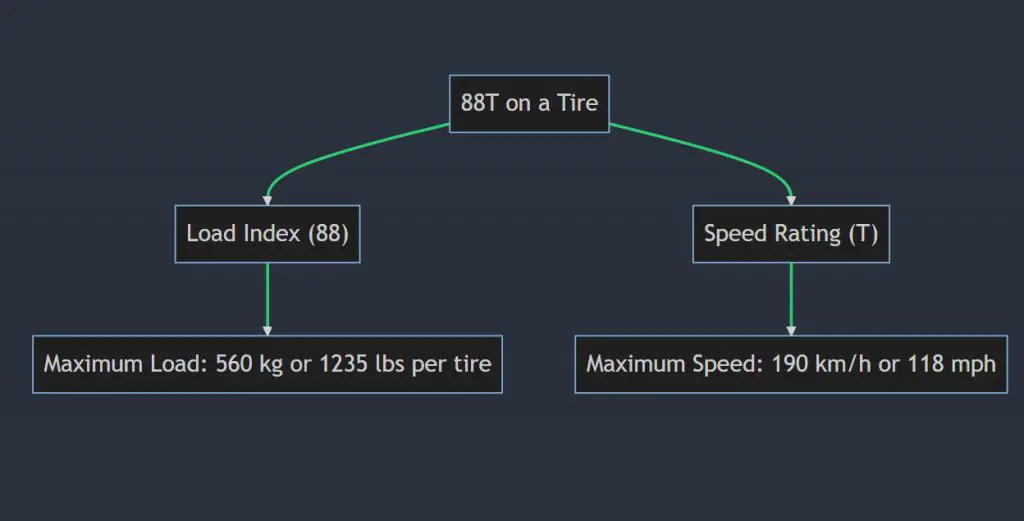
Specifics about 88T Tires
The 88T tires, often considered the automotive equivalent of sensible shoes, might lack the glamour of their higher-rated counterparts, but they make up for it in practicality and suitability for a wide range of vehicles.
Typical Use Cases for 88T Tires
These tires are commonly seen in sedans, minivans, and compact SUVs. They are the go-to choice for drivers who prioritize safety, comfort, and fuel efficiency over high-speed performance. These tires are also a match made in heaven for those who appreciate a quiet ride, as they tend to generate less road noise.
Vehicles Suitable for 88T Tires
- Honda Accord
- Toyota Camry
- Nissan Altima
- Ford Fusion
- Chevrolet Malibu
- Subaru Outback
- Honda CR-V
- Subaru Forester
Precautions when Using 88T Tires
While 88T tires are the workhorses of the tire world, like any piece of equipment, they must be used within their limits. They’re not suitable for high-performance or sports cars that often need to travel at higher speeds. Also, ensure to check your vehicle’s owner manual or consult a tire professional to confirm that 88T tires are appropriate for your car and driving needs.
FAQ’s
1. Can I replace 88T tires with a higher speed rating?
Yes, you can always go up in speed rating, but make sure it complies with your vehicle’s requirements.
2. Can I use 88T tires for off-roading?
Typically, 88T tires are not designed for off-road use. For off-roading, it’s best to use tires specifically designed for that purpose.
3. Is it okay to use 88T tires in snowy conditions?
While 88T tires can handle light snowy conditions, for severe winter conditions, it’s recommended to use winter tires which have better traction and performance in cold weather.
[amazon box=”B01A0PRYW6″ grid=”2″]
What does 88S mean on a tire?
The “88S” on a tire represents the tire’s load index and speed rating. The number ’88’ corresponds to a load index, signifying that each tire can support up to 1235 lbs. or 560 kg.
The ‘S’ is the speed rating, indicating that the tire can safely operate at speeds up to 112 mph or 180 km/h. It’s important to note that the speed rating is not a recommendation to exceed speed limits. Instead, it indicates the maximum speed at which the tire can carry a load corresponding to its load index under optimal conditions.
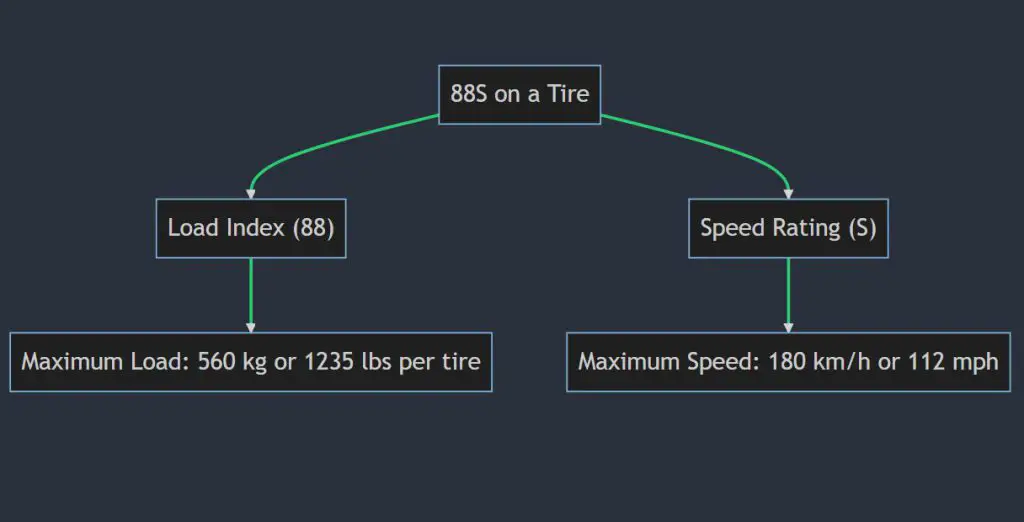
Specifics about 88S Tires
Now that we’ve unraveled the meaning of the 88S tire code, let’s delve into the nitty-gritty specifics of these types of tires.
Typical Use Cases for 88S Tires
88S tires are often found on light-duty vehicles such as compact cars, sedans, and minivans. They provide a good blend of performance, safety, and comfort for everyday driving in city traffic and occasional highway use.
Vehicles Suitable for 88S Tires
The beauty of 88S tires lies in their versatility. These sturdy companions suit a variety of vehicles, including:
- Toyota Corolla
- Honda Civic
- Hyundai Elantra
- Nissan Sentra
- Ford Fiesta
- Volkswagen Golf
Precautions when Using 88S Tires
When using 88S tires, always remember to check your vehicle’s manual to ensure these tires are a fit for your vehicle. Furthermore, 88S tires are not suited for high-performance driving, so don’t go chasing after sports cars!
FAQ’s
1. Can I replace 88S tires with 88T tires?
Yes, you can, since T-rated tires have a higher speed rating than S-rated tires. Always consult your vehicle’s manual or a tire professional first, though!
2. Are 88S tires suitable for winter driving?
While 88S tires can handle mild winter conditions, for severe snow or icy conditions, it’s always safer to switch to winter tires.
3. Can 88S tires be used for off-roading?
Generally, 88S tires aren’t designed for off-roading. For such adventures, you’d want to look at tires specifically designed to handle off-road conditions.
What does 88Q mean on a tire?
On a tire, “88Q” refers to the load index and speed rating of the tire. The number 88 indicates that each tire can support a maximum weight of 1235 lbs., or 560 kg. The letter ‘Q’ denotes a speed rating, indicating that the tire can safely operate at speeds up to 99 mph or 160 km/h under optimal conditions.
Like its other siblings in the tire family, this rating does not recommend you to blaze past speed limits but gives you an understanding of your tire’s safe operational speed.
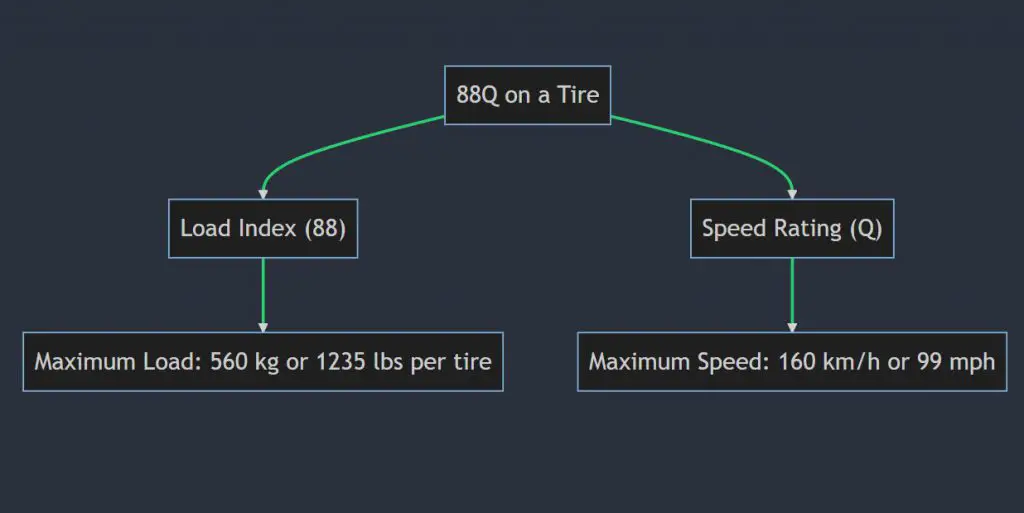
Specifics about 88Q Tires
To get under the treads of 88Q tires, we must explore some specifics that make these tires a great choice for particular circumstances.
Typical Use Cases for 88Q Tires
88Q tires find their homes predominantly on vehicles designed for winter driving or light off-roading. Their lower speed rating is conducive to vehicles and driving situations that require more control and less outright speed.
Vehicles Suitable for 88Q Tires
These dependable, hardy tires fit a variety of vehicles. Their unique characteristics make them suitable for:
- Subaru Forester
- Honda CR-V
- Toyota RAV4
- Nissan Rogue
- Ford Escape
- Jeep Compass
Precautions when Using 88Q Tires
While 88Q tires have many advantages, they’re not suited to high-speed performance driving. Always ensure that the tires are suitable for your specific vehicle and its driving conditions by consulting your vehicle’s manual or a tire expert.
FAQ’s
1. Can I replace 88Q tires with 88S tires?
Yes, you can replace 88Q tires with 88S tires as they have a higher speed rating. But always consult your vehicle’s manual or a tire professional before making such a switch.
2. Are 88Q tires suitable for heavy snow or ice?
While 88Q tires are more capable in winter conditions than some other tires, in heavy snow or icy conditions, it’s recommended to use specific winter tires.
3. Can I use 88Q tires in the summer?
Yes, 88Q tires can be used in the summer, but they may not perform as well as tires designed specifically for warm weather.
[amazon box=”B07BFJDLTB” grid=”2″]
What does 88h mean on a tire?
The “88H” printed on a tire refers to its load index and speed rating. The number ’88’ corresponds to the load index and it signifies that each tire can support a weight of up to 1235 lbs. or 560 kg. The letter ‘H’ is the speed rating, denoting that the tire can maintain performance at speeds up to 130 mph or 210 km/h under optimal conditions. This is not an invitation to turn every road into a racing track, but a measure of the tire’s safe operating speed under ideal conditions.
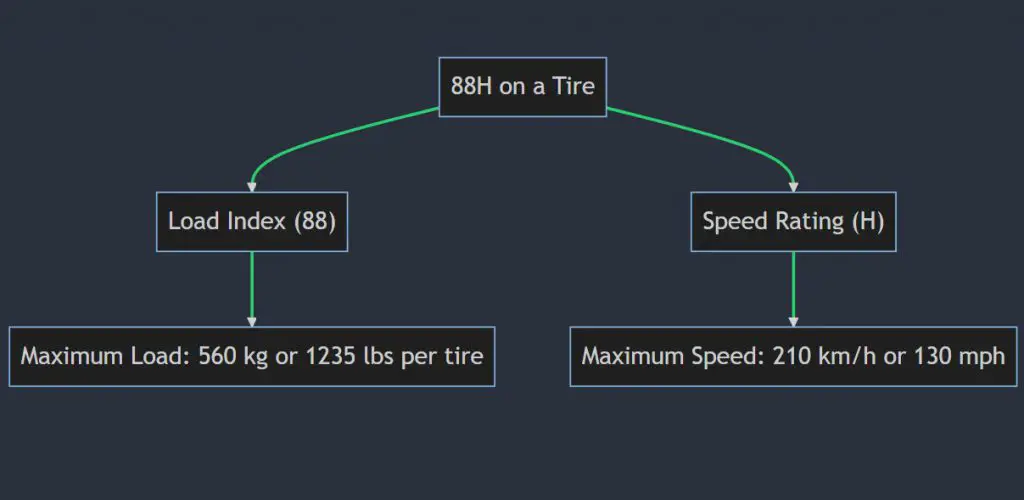
Specifics about 88H Tires
With the basics down, let’s get into the rubbery details of the 88H tires.
Typical Use Cases for 88H Tires
88H tires are commonly found on midsize sedans, family wagons, and small SUVs. They offer a balance of performance, comfort, and safety for regular commuting and highway driving.
Vehicles Suitable for 88H Tires
These versatile tires are a great fit for a wide range of vehicles, including:
- Honda Accord
- Toyota Camry
- Nissan Altima
- Ford Fusion
- Subaru Outback
- Chevrolet Malibu
Precautions when Using 88H Tires
While 88H tires can handle higher speeds, it’s crucial to always drive within the speed limits and conditions of the road. Always consult your vehicle’s manual to ensure these tires are appropriate for your car.
FAQ’s
1. Can I replace 88H tires with 88S tires?
It’s not recommended as S-rated tires have a lower speed rating than H-rated tires. Always check with a tire professional before replacing tires with a different speed rating.
2. Are 88H tires suitable for winter?
While 88H tires can handle mild winter conditions, it’s advisable to switch to winter tires for better traction and performance in snowy and icy conditions.
3. Can 88H tires be used for off-roading?
Generally, 88H tires are not designed for off-road use. You’d want to use tires specifically designed for off-roading.
[amazon box=”B00PUFA39S” grid=”2″]
What does 88r mean on a tire?
“88R” on a tire specifies the load index and speed rating of the tire. The number ’88’ stands for a load index, suggesting that each tire can support up to 1235 lbs or 560 kg. The ‘R’, on the other hand, represents the speed rating. This speed rating implies that the tire can safely operate at speeds up to 106 mph or 170 km/h under optimal conditions. Remember, the speed rating isn’t an encouragement to speed, but an indicator of your tire’s maximum safe speed.
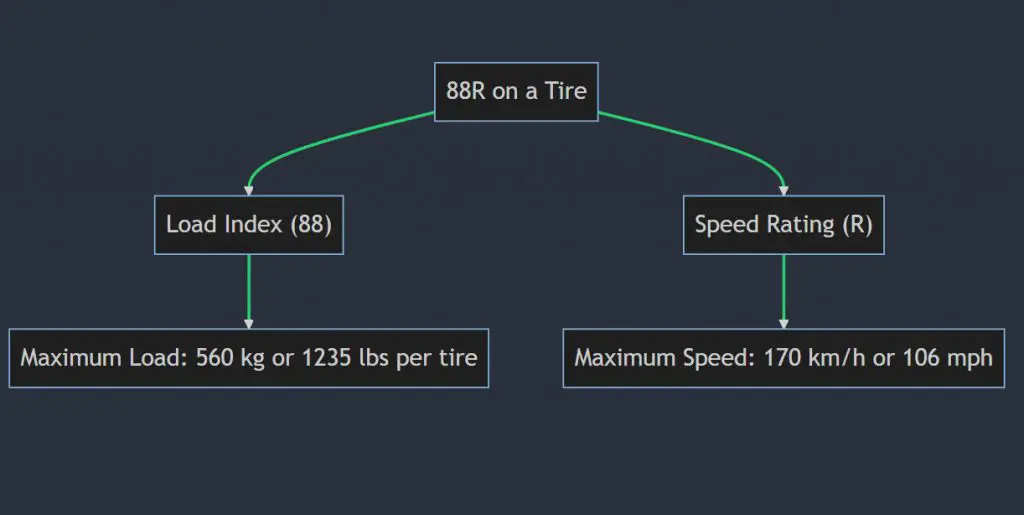
Specifics about 88R Tires
Let’s dive into some specifics that make these 88R tires a perfect companion for certain vehicles and uses.
Typical Use Cases for 88R Tires
88R tires are typically found on lightweight trucks, SUVs, and vans. They are designed to handle a combination of passenger and cargo loads and offer a comfortable ride on most surfaces.
Vehicles Suitable for 88R Tires
Here are some of the vehicles which are typically equipped with 88R tires:
- Ford Ranger
- Toyota Hilux
- Mitsubishi L200
- Nissan Navara
- Volkswagen Amarok
Precautions when Using 88R Tires
Ensure to consult your vehicle’s manual or a tire professional to confirm that 88R tires are suitable for your vehicle. These tires are not designed for high-speed or high-performance vehicles.
FAQ’s
1. Can I replace 88R tires with 88H tires?
Yes, H-rated tires have a higher speed rating than R-rated tires. However, always check with your vehicle’s manual or a tire professional before making such changes.
2. Are 88R tires suitable for off-road use?
While they can handle some off-road conditions better than regular passenger tires, for severe off-road conditions, it’s best to use dedicated off-road or all-terrain tires.
3. Can I use 88R tires in the winter?
While 88R tires can handle mild winter conditions, for heavy snow or icy conditions, it’s recommended to use dedicated winter tires.
[amazon box=”B07BFJ2ZHM” grid=”2″]
What does 88v mean on a tire?
The “88V” on a tire refers to the tire’s load index and speed rating. The number ’88’ means that each tire can carry a maximum weight of 1235 lbs., or 560 kg. The ‘V’ is a speed rating, indicating that the tire can sustain speeds up to 149 mph or 240 km/h under optimal conditions. As usual, this doesn’t mean you should test the limits of the speed rating on public roads – it’s simply a measure of the tire’s performance capabilities.
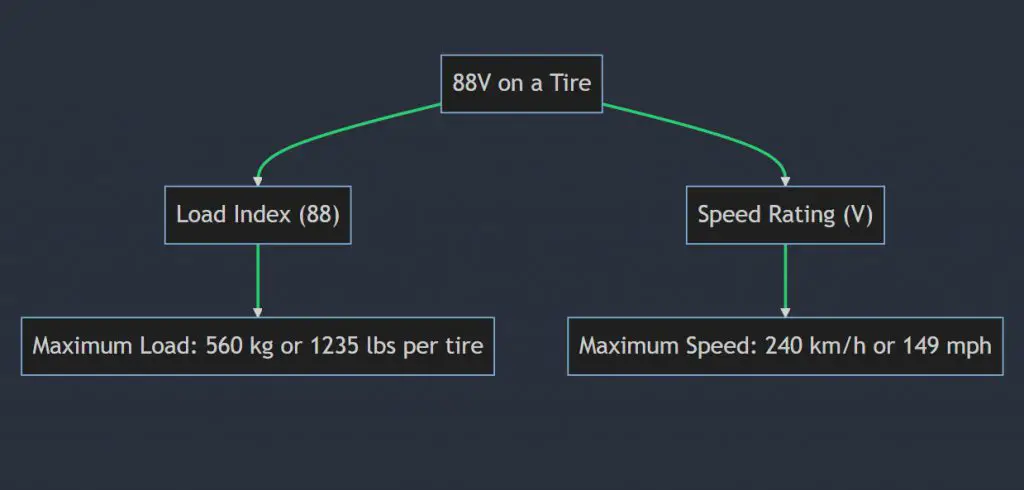
Specifics about 88V Tires
Let’s get into some specific characteristics that make these 88V tires unique.
Typical Use Cases for 88V Tires
88V tires are typically seen on higher performance sedans, sports cars, and some high-performance SUVs. They deliver excellent handling and ride comfort at higher speeds.
Vehicles Suitable for 88V Tires
These performance-oriented tires are a great match for vehicles such as:
- BMW 3 Series
- Mercedes-Benz C-Class
- Audi A4
- Lexus IS
- Infiniti Q50
Precautions when Using 88V Tires
As 88V tires are performance-oriented, they may not deliver the same longevity as tires with lower speed ratings. Always check the suitability of these tires for your vehicle by consulting your vehicle’s manual or a tire professional.
FAQ’s
1. Can I replace 88V tires with 88H tires?
While you technically can, it’s not recommended as H-rated tires have a lower speed rating than V-rated tires. Always consult with a tire professional before switching to a tire with a different speed rating.
2. Are 88V tires suitable for winter?
Unless specifically designated as all-season or winter tires, 88V tires may not perform optimally in winter conditions. It’s recommended to use specific winter tires for snowy or icy conditions.
3. Can 88V tires be used for off-roading?
Generally, 88V tires are not suitable for off-roading. For off-road conditions, it’s best to use tires specifically designed for this purpose.
[amazon box=”B08F8T4NN3″ grid=”2″]
What does 88W mean on a tire?
When you see “88W” on a tire, you’re looking at the load index and speed rating. The number ’88’ represents a load index, suggesting each tire can bear a load of up to 1235 lbs or 560 kg.
The letter ‘W’ is the speed rating, signifying that the tire can maintain optimal performance at speeds up to 168 mph or 270 km/h. Just as a gentle reminder, this speed rating is not a green light to make highways your personal racetracks. It’s a measure of the tire’s performance capabilities under ideal conditions.
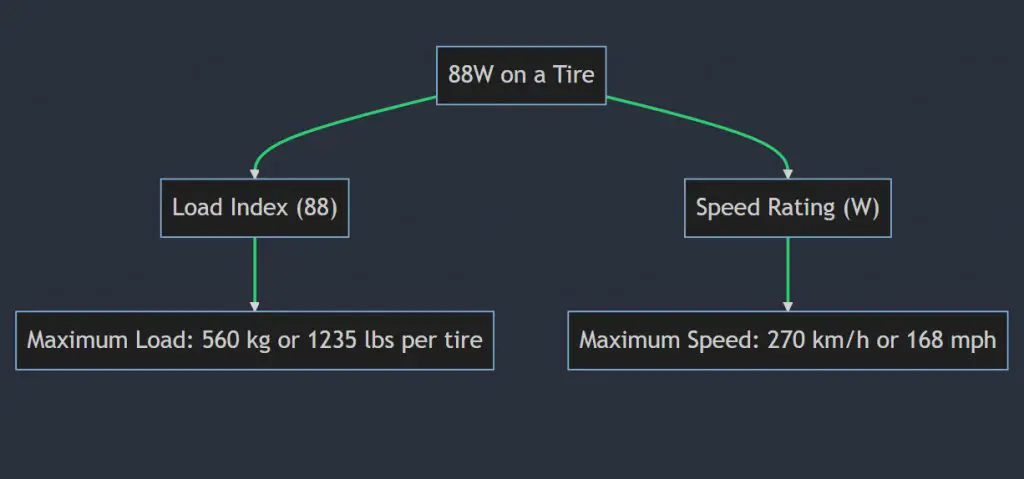
Specifics about 88W Tires
Now that we’ve covered the basics, let’s dive into some specific characteristics of the 88W tires.
Typical Use Cases for 88W Tires
88W tires are typically found on high-performance sports cars and luxury sedans. These tires provide excellent stability and handling at higher speeds, ensuring a smooth and thrilling ride.
Vehicles Suitable for 88W Tires
Here are some examples of vehicles which are typically fitted with 88W tires:
- Porsche 911
- BMW M3
- Audi S4
- Mercedes-Benz AMG C63
- Jaguar XE SV Project 8
Precautions when Using 88W Tires
While 88W tires deliver exceptional performance at high speeds, remember they might not last as long as tires with lower speed ratings. Always ensure these tires are a suitable choice for your vehicle by consulting your car’s manual or a tire professional.
FAQ’s
1. Can I replace 88W tires with 88V tires?
Technically, you can, but it’s not advised. V-rated tires have a lower speed rating than W-rated tires. Always consult a tire professional before making such changes.
2. Are 88W tires suitable for winter?
Unless they are specifically labeled as all-season or winter tires, 88W tires may not perform well in snowy or icy conditions. It’s recommended to use winter tires in such conditions.
3. Can 88W tires be used for off-roading?
No, 88W tires are not suitable for off-roading. Off-roading requires specific types of tires designed for such use.
FAQs
1. What is the difference between 88T and 88H?
The main difference between 88T and 88H lies in the speed rating. While both have the same load capacity (560 kg or 1235 lbs), 88T tires have a speed rating of 118 mph (190 km/h), and 88H tires can handle speeds up to 130 mph (210 km/h). Thus, 88H tires are better suited to vehicles that require more speed capacity.
2. How does 88S differ from 88H?
Again, the divergence here is in the speed rating. Both 88S and 88H tires have an identical load capacity of 1235 lbs or 560 kg. However, the 88S has a speed rating of 112 mph (180 km/h), while the 88H can support speeds of up to 130 mph (210 km/h). Therefore, if your vehicle requires higher speed capabilities, 88H would be the better choice.
3. What sets 88Y apart from 88W?
88Y and 88W tires have the same load capacity but differ significantly in speed ratings. 88Y tires have a speed rating of 186 mph (300 km/h), making them some of the fastest tires on the market. In contrast, 88W tires have a speed rating of 168 mph (270 km/h). Hence, if you’re lucky enough to own a supercar, 88Y tires might be just what you need!
[amazon box=”B00MTZPVVM” grid=”2″]
Recap And Summary
In summary, the numbers and letters on your tires aren’t part of a secret code – they tell you important information about the tire’s load capacity and speed rating. So, whether you’re gearing up for a cross-country trip, or simply cruising around town, understanding these markings can help you make an informed decision when it’s time to replace your tires.
And just remember, while your tires might be able to handle a certain speed, it’s always essential to stick to the speed limits and drive safely. Always consult your vehicle’s manual or a tire professional to ensure the appropriate tires are chosen for your vehicle and driving conditions. And with that, we’ll put the brakes on this topic for now. Until next time, keep the rubber side down and the shiny side up!
Alternative Tire Size Codes of Similar Specifications

AR Jeet has been a tire mechanic for over 2years. He has worked on all types of vehicles, from cars and trucks to RVs and ATVs and motorcycles. He has seen it all when it comes to tires, and he knows how to fix them.
AR Jeet is a tire expert, and he is passionate about his work. He loves to help people keep their vehicles running smoothly, and he is always happy to answer any questions that people have about their tires.
If you need help with your tires, or if you just want to learn more about them, then AR Jeet is the man to talk to. He will be happy to help you out, and he will make sure that you get the best possible solution.
He has a blog [Tirespick.com] where he writes about all things tire-related, and he is always happy to help people with their tire needs. Know more about AR Jeet.
